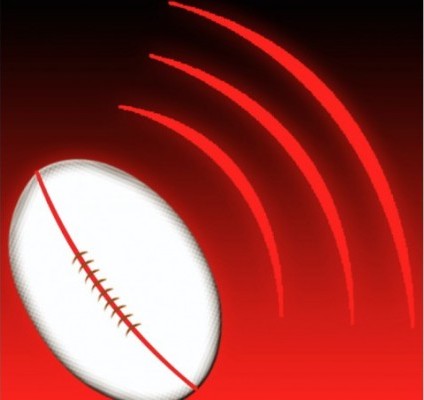Black Ferns Rain 50 Down on USA Women
Black Ferns Rain 50 Down on USA Women
New Zealand put the USA to the sword in the rain in Whangarei Saturday, with the Black Ferns defeating the Eagles 50-6.
This article contains opinion/analysis
Speed kills, so they say, and speed was the story in this game. It wasn't that the New Zealanders were necessarily faster as individuals, but their game certainly was. The Black Ferns game plan essentially trash-canned what most rugby teams do, doing away with the slow rucks, or even rucks at all.
When New Zealand did clear out, they did so with great violence, making a jackal or even a contested ruck a bad idea for the defense.
Whether this was safe or even legal we might leave up to others to decide. Certainly, if the Black Ferns were guilty of diving on the ball or coming in from the side, they were doing it so rapidly and powerfully that it was difficult for any official to recognize ... and the ball was usually away before anyone had time to think.
And that last bit was certainly true. New Zealand kept the offloads moving, they spun the ball to a runner almost instantly the tackle had been created, and they passed. Oh did they pass. Inside pops from the scrumhalf to a forward, out-and-in linkages between forwards, or backs offloading at full pace.
The speed of the New Zealand game meant that the Eagles had very little time to set their defense, and if one player was sucked in to help make a tackle, the ball was off to the support runner with a big old gap in front of here.
This is the story of the New Zealand vs USA game. While the Eagles did (or failed to do) several things that made it harder on them, the Black Ferns style of essentially always having the ball moving and always having confident, athletic runners going forward onto the ball allowed them to dominate the game.
Ayesha Leti-L'iga scored three tries for the Black Ferns and five others touched down. The USA got two well-taken Megan Foster penalties for their work.
Positives for the USA
The Eagle set piece is really good. Their scrum was better than New Zealand's and the USA won several penalties, drove New Zealand back, and overall were in good shape in that aspect of play. The front row of Hope Rogers, Jojo Kitlinski, and Nick James (with Charlie Jacoby coming on at about 50 minutes) was very strong.
The lineout, too, operated nicely and while the Black Ferns had one or two hiccups there, the Eagle lineout did the job. Their maul and their maul defense is also really good.
Defensive, obviously the USA gave up eight tries, but the positive here was that, with one or two glaring exceptions, this wasn't for lack of ability or desire to tackle. There is a power differential between the two teams, meaning too often more than one American was required to take a ballcarrier down, but generally the players worked hard to make their tackles.
The Eagles got into scoring position on several occasions; they didn't buckle while playing in very difficult conditions, and the kicking game was, overall, pretty good.
Negatives for the USA
This USA team cannot score tries. There's no way to sugarcoat it. Since Rob Cain took over the team in 2018, the Eagles are 3-13. That in itself isn't all that surprising given that the USA plays very tough teams. But in those 16 games they have been held tryless six times, and scored only one try in six others. The continuity of attack options out wide just isn't there. They run a play, win a ruck, run something else, and lose the ball. When something promising gets going, someone intercepts a pass or a tackle pops the ball loose (this was an especially harsh moment for the Eagles on Saturday). When they do have continuity, they don't have consistent go-forward.
The ball is excruciatingly slow out of the ruck, and so in the end the USA scoring chances come off penalties committed by an impatient defense. This is exactly how the USA's best try-scoring chance came.
This was midway through the first half. The USA got a penalty and took the lineout to set up a maul. Kate Zackary was hit while she was in the air, so another penalty for the USA. There followed then a slow decision-making process that resulted in a couple of scrum penalties from New Zealand. Another nation might have seen a yellow card at this point (the scrums were five meters from the New Zealand line), but we all know that there are varying standards on that. Had the USA been playing Italy, one Italian prop would have been in the sin bin.
Regardless, finally Zackary took a tap and went for the line. One of the very best USA players, Zackary we are sure would tell you herself she was too high in contact. The Black Ferns stopped her. They stopped the next couple of charges, and then Foster let a pass slide through her hands and that was it.
The lesson there is that the USA either has to dance with the one that brung them (lineout and maul), or have a real, concerted plan for how to score off a tap penalty. But options were limited, and ball presentation and use was slow.
Players
Hope Rogers is a world-class prop. Jordan Matyas at lock is an inspired choice and her work rate was impressive. Carly Waters brings a dose of energy at scrumhalf and her delivery was quicker and more direct than we saw vs England last fall. Rachel Johnson was immense at openside flanker.
Most of the other players did some very good things and had trouble elsewhere. A couple of players played poorly, couldn't tackle, and raised serious questions as to whether they should be picked in the future.
Most of the issues within the backline can be traced to unity. Cain had three different scrumhalf-flyhalf combinations in the Pacific Four. He shifted around other combinations as well, clearly looking for some answers to who would be best for the World Cup later this year. But what that developed was mistakes of unity—Alev Kelter is an excellent player, who was out of position defensively at key moments. Katana Howard is a devastating strike runner at inside center, trying to develop a relationship with two very different flyhalves.
The Upshot
New Zealand won the Pacific Four. Canada beat Australia to finish 2nd, and the USA was third over Australia. Shockingly, the USA is ranked #5 in the world. They won't lose any rankings points for this loss (the formula World Rugby uses has New Zealand so far ahead this result was expected by the system), but it's weird to see them ranked that highly despite the losses (especially November loss to Ireland).
But what you will probably see from this team is that it is tougher and more resilient than you might expect. In the World Cup, one would expect them to be able to beat Italy and Japan, and then we can see how they handle Canada in their final pool game. Those two wins, however, would put them in the quarterfinals.
The bones of this team are good. The pack is strong and the scrum, lineout, and maul are all functioning nicely. Defensively, despite the 50 New Zealand scored, the Eagles are not in a bad place.
The kicking game and the number of players who can get points under pressure (Foster, Kelter, and Gabby Cantorna) is a good thing. The flesh that needs to be put onto those bones is the ability to open up defenses in open play. Right now we haven't seen much of that since the 2019 Super Series. So that's the work-on for the next three-and-a-half months.
The USA Women's National 15s team has to find the right combination of talent in the backline that is athletic, yes, but, more importantly, works together. The team needs to replace the defensive gaps they have. They need to find a way to get turnovers in the breakdown. And whether it's by battering ram or stealth, flare or grit, they need to score tries.











